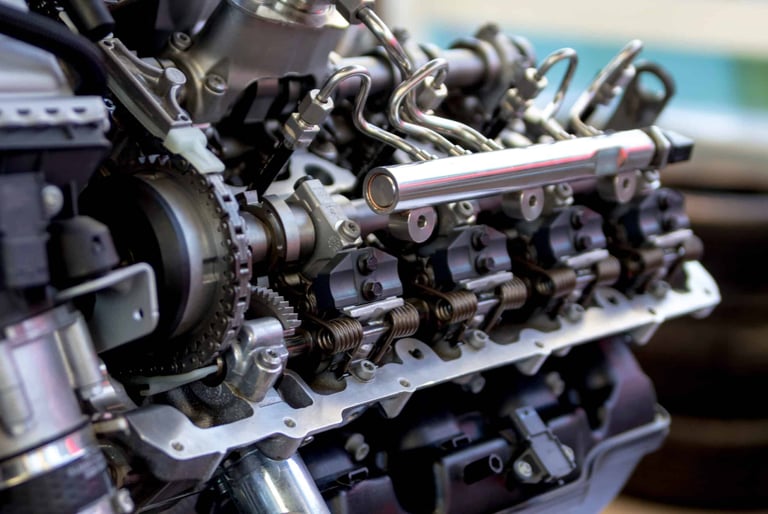
Geometrical Tolerancing in Automotive
Practical training in geometrical tolerancing, tailored for the Automotive and Industrial Machinery sector.


Course Description:
This intensive programme introduces the fundamental principles of geometrical tolerancing, with a focus on the aspects most relevant to the Automotive and Industrial Machinery sector. The course can be delivered to either BS 8888 & ISO GPS or ASME Y14.5 standards, depending on client requirements.
Course Objectives:
By completing this course, participants will:
Build a strong foundation - grasp the core principles that make the standards easier to understand
Master the essentials - become fluent in the key terminology, rules, and most commonly used symbols from the standards.
Apply with purpose - learn when and how to use tolerance symbols effectively, and how the standards are used, interpreted and applied across a part’s life cycle.
Design for function - see how correct datum and tolerancing strategy enables a requirements-driven approach, ensuring fitness for purpose and unambiguous capture of design intent.
Bridge textbook theory with practical application - Learn how tolerancing strategy is shaped by manufacturing and inspection realities.
Gain practical confidence - work with real Automotive & Industrial drawings and parts to see how the standards drive better design intent, clearer communication, and more efficient production.
Who it is for:
This course is designed to be accessible to newcomers to the standards as well as those with prior experience, within the Automotive and Industrial Machinery sector.
The course is particularly valuable for:
Design and Mechanical Engineers
Inspectors and Inspection Planners
Drafters
Machinists, Operators, and Tooling Engineers
Sales, Purchasing, and Quality personnel
Managers, Supervisors, and Production Associates
Anyone who needs to read, interpret, or work with the standards on engineering specification
Requirements:
Participants should have some familiarity with engineering drawings and a background in design, production, or inspection, including the ability to interpret how parts are represented on drawings.
Delegates don't need to bring materials, laptops etc. All materials are provided by GD&T Academy.
Participants are welcome to supply drawings or components, which may be integrated into exercises to enhance course applicability.
An upper limit of 10 delegates is advised to ensure effective learning.
Materials provided:
Detailed course notes including drawing examples
Workbook with exercises and other printable handouts
Quizzes and knowledge checks to gauge progress throughout the course
Certificate of course completion
Delivery Format:
Onsite or online delivery
Duration:
3 days
Course Syllabus - BS8888 & ISO GPS:
Core Content:
Foundations of Geometrical Tolerancing - Principles, benefits, and standards in context (ISO 8015, ISO 17450, BS 8888)
Features & Size Control - Features of size, size tolerances and the Envelope Requirement (ISO 14405-1)
Datums & Datum Systems - Defining, constructing, and selecting datums; controlling 6 degrees of freedom, datum feature indicator, datum targets, common datums (ISO 5459)
Geometrical Tolerances - Characteristic symbols, tolerance indicators, tolerance features, modifiers and Theoretically Exact Dimensions (TEDs), tolerance characteristics & application, Profile Tolerances (ISO 1101, ISO 1660)
General Tolerances: Linear & Angular tolerances, General geometrical specifications and general size specifications (ISO 2768, ISO 22081)
Industry Specific Content & Application:
Maximum Material Requirement and Bonus Tolerance
Application on combustion engine parts, e.g. cylinder head, piston, camshaft, flywheel housing
Application on Suspension parts, e.g. shock absorber mounting
Application on cherry picker, fork lift parts
Course Syllabus - ASME Y14.5:
Core Content:
Foundations of Geometrical Tolerancing - Principles, benefits, and standards in context
Features & Size Control - Features of size, size tolerances and Rule #1
Datums & Datum Systems - Defining, constructing, and selecting datums; controlling 6 degrees of freedom, datum feature indicator, datum targets, common datums
Geometrical Tolerances - Characteristic symbols, Feature Control Frame, tolerance features, modifiers and Basic Dimensions, tolerance characteristics & application, Profile Tolerances
Industry Specific Content & Application:
Maximum Material Condition and Bonus Tolerance
Application on combustion engine parts, e.g. cylinder head, piston, camshaft, flywheel housing
Application on Suspension parts, e.g. shock absorber mounting
Application on cherry picker, fork lift parts
To book a course, discuss possible dates, or for further information:
About This Course:
"Bridging the Gap Between Theory and Practice"
GD&T Academy
UK office:
8 Lanercost Crescent Milton Keynes
MK10 9EB
Phone: +44(0)7887748891
© 2025. All rights reserved.
